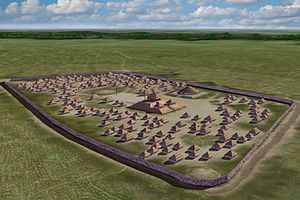
Pacaha was a Native American polity encountered in 1541 by the Hernando de Soto expedition. This group inhabited fortified villages in what is today the northeastern portion of the U.S. state of Arkansas.
The tribe takes its name from the chieftain Pacaha (born in the early 16th century), who ruled the tribe from its primary village on the Mississippi River, which was thought to be located in present-day Crittenden County, Arkansas near Turrell. The site, part of the Nodena phase, is known to archaeologists as "The Bradley Site".[1] Information about Chief Pacaha and his people comes from journals made during the expedition of Hernando De Soto in 1541. The de Soto expedition stayed at Pacaha's village for approximately 40 days.
- ^ Morse, Dan F. (1973). Nodena-An account of 90 years of archaeological investigation in southeast Mississippi County, Arkansas. Arkansas Archaeological Survey Research Series. ISBN 1-56349-057-9.